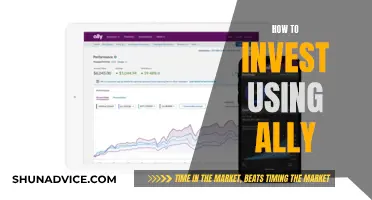
Moving investments to cash is a complex decision that requires careful consideration of various factors. It involves converting investments such as stocks, bonds, or mutual funds into cash, which can be held in savings accounts, money market funds, or other liquid assets. This decision is typically made when individuals want to reduce their exposure to volatile stock markets or need access to cash for short-term goals. While holding cash can provide psychological comfort and help avoid short-term losses, it is important to weigh the potential benefits against the opportunity cost of missing out on long-term gains in the stock market. Additionally, inflation erodes the purchasing power of cash over time, making it a less attractive option for long-term investment strategies. To make an informed decision, individuals should seek guidance from financial advisors, evaluate their risk tolerance, and consider their investment goals and time horizon.
| Characteristics | Values |
|---|---|
| Definition of cash | Paper bills, checking and savings account balances, money market mutual funds, CDs, short-dated bonds |
| When to go to cash | If you have more money than you'll ever need and don't need to take on any more risk |
| Cash as part of a financial plan | Recommended to have 3-6 months' worth of emergency savings in a cash account |
| Cash vs. stocks | Cash doesn't grow in value and is prone to inflation; stocks are volatile but historically deliver higher returns |
| Cash vs. retirement savings | Cashing out retirement savings early may incur taxes and penalties |
| Cash vs. in-kind transfer | In-kind transfer avoids taxation consequences of selling investments |
| Cash vs. cash transfer | Cash transfers have fewer fee requirements and nominal fees |
What You'll Learn

When to move investments to cash
Long-term vs. Short-term Goals:
- Long-term goals: If your investment goals are at least five years away, such as retirement, buying a house, or saving for college tuition, moving investments to cash might not be the best strategy. Historically, the stock market has provided better returns over the long term, and moving to cash could result in losing potential gains.
- Short-term goals: For goals less than five years away, such as an emergency fund or a vacation fund, it is generally not recommended to invest in the stock market at all. Instead, consider keeping this money in a savings account or other low-risk, liquid investments.
Risk Tolerance and Market Volatility:
- Risk tolerance: If you have a low-risk tolerance and are uncomfortable with the volatility of the stock market, moving a portion of your investments to cash can help reduce risk. However, it's important to remember that cash itself carries inflation risk, and there may be alternative investments, such as bonds or diversified portfolios, that can provide more stable returns without completely sacrificing growth potential.
- Market volatility: During periods of high market volatility or an impending market downturn, it might be tempting to move investments to cash to avoid losses. However, it is challenging to time the market correctly. Instead of trying to predict market peaks and troughs, consider rebalancing your portfolio to match your risk tolerance and market outlook.
Retirement Planning:
- Retirement accounts: When considering moving investments to cash in retirement accounts, such as 401(k)s or IRAs, it's important to weigh the tax implications. Withdrawing funds early or for non-qualified reasons may result in taxes and penalties. Additionally, retirement accounts often provide tax advantages, and moving funds to cash could forfeit these benefits.
- Retirement income: For retirees or those approaching retirement, it is common to keep a portion of their investments in cash or cash equivalents to cover living expenses for a few years. This strategy ensures that they have stable, accessible funds and are not forced to sell investments during a market downturn.
Interest Rate Environment:
- Interest rates: In a rising interest rate environment, some cash investments, such as savings accounts, money market funds, and short-term bonds, become more attractive as they offer higher yields. Locking in these higher yields can be beneficial, especially if you expect interest rates to decrease in the future.
- Opportunity cost: On the other hand, if interest rates are expected to remain high for an extended period, staying invested in the stock market might provide better returns over the long term. Weigh the potential gains in the stock market against the growth of a cash portfolio, considering the impact of inflation on both options.
In summary, the decision to move investments to cash depends on a combination of factors, including your financial goals, risk tolerance, time horizon, market conditions, and the opportunity cost of alternative investments. It is generally not advisable to move all your investments to cash, as it can result in losing potential gains and may not align with your long-term financial objectives. Consult with a financial advisor to determine the appropriate strategy for your specific circumstances.
Dividends: Cash Flow from Investing?
You may want to see also

How to sell investments
There are several ways to sell investments, and the best option depends on your personal financial situation and goals. Here are some common methods for selling investments:
Selling Stocks
If you own individual stocks, you can sell them through a brokerage account or investment platform. You can place a market order to sell at the current market price or set a limit order to sell only if the stock reaches a certain price. Keep in mind that selling stocks incurs capital gains tax, and you may want to consult a tax advisor before proceeding.
In-Kind Transfer
An in-kind transfer allows you to move investments between brokers without selling them. This option is usually available for investments such as stock options, mutual funds, bonds, and exchange-traded funds. However, some investments may not be supported by the receiving broker, in which case you would need to sell them and transfer the cash proceeds. In-kind transfers can help you avoid taxation consequences from selling investments, but proper coordination is necessary to ensure a smooth process.
Liquidating Assets into Cash
You can also choose to liquidate your assets into cash before transferring them to a new account or investment option. This option provides flexibility, especially if you plan to diversify your investments across different brokers or platforms. However, liquidating assets may result in losing potential returns, and it can be challenging to track the cost basis for non-registered accounts.
Using a Robo-Advisor
If you prefer a more hands-off approach, you can use a robo-advisor service. These automated platforms use algorithms to manage your investments for you, offering features such as automatic rebalancing and tax optimization. They are typically more affordable than traditional financial advisors, making them a popular choice for those who want professional help without the high fees.
Timing the Market
Some investors try to time the market by selling their investments when they believe the market is about to decline and buying when they anticipate an upward trend. However, this strategy is challenging to execute successfully, and most financial advisors caution against it. Instead, a long-term investment strategy that focuses on asset allocation and diversification is generally recommended.
Remember, when deciding how to sell your investments, it's essential to consider your financial goals, risk tolerance, and time horizon. Different investment options have varying levels of liquidity, flexibility, and potential returns, so choosing the right approach for your specific needs is crucial.
Maximizing Your Spare Cash: Smart Investing Strategies
You may want to see also

Cash and inflation
Cash is king, but inflation can quickly devalue it. Inflation is a decrease in the purchasing power of money, reflected in a general increase in the prices of goods and services in an economy. It occurs when there is an increase in the supply of money and credit, stimulating demand for goods and services to increase more rapidly than the economy's production capacity. This creates a demand-supply gap, with higher demand and less flexible supply, resulting in higher prices.
Inflation can be classified into three types: demand-pull inflation, cost-push inflation, and built-in inflation. Demand-pull inflation occurs when demand for goods and services grows faster than the economy's capacity to produce them. Cost-push inflation happens when the cost of producing goods and services rises, forcing businesses to charge more. Built-in inflation is related to the idea that people expect current inflation rates to continue in the future, so they demand higher wages to maintain their standard of living, which in turn increases the cost of goods and services.
The impact of inflation on cash is that it loses value over time. If you keep cash under your mattress, it will be worth less in the future than it is today. This is because inflation erodes the purchasing power of money – one unit of money buys fewer goods and services. This loss of purchasing power increases the cost of living for people, which can lead to a deceleration in economic growth.
To protect cash from the effects of inflation, individuals can invest in asset classes that typically outperform the market during inflationary times, such as commodities (e.g. grain, beef, oil, electricity, and natural gas), real estate, and precious metals (e.g. gold and silver). They can also invest in Treasury Inflation-Protected Securities (TIPS), a type of security indexed to inflation to protect against declines in purchasing power.
Another way to safeguard cash from inflation is to choose accounts that earn a return higher than the inflation rate, such as money market or high-yield savings accounts. For example, if the inflation rate is 2%, an individual would need to earn a return of more than 2% on their savings account to maintain their purchasing power.
It's important to note that different countries experience different rates of inflation, and central banks play a crucial role in keeping inflation in check through monetary policy. In the US, the Federal Reserve aims to keep inflation at 2% over the long run and uses various tools such as managing the federal funds rate, altering reserve requirements, and changing the money supply to achieve this goal.
Depreciation's Impact on Cash Flow: Investing Activities
You may want to see also

Opportunity cost of holding cash
Holding cash can be a powerful tool in a volatile market, but it is not without its opportunity costs. Cash is often seen as a drag on portfolios when stock markets are booming, but in a bear market, it can be a lifesaver and a tool to buy assets when their prices fall. However, holding onto cash for too long can result in a loss of value, making it a depreciating asset.
The opportunity cost of holding cash is the potential loss of value compared to other assets. For example, if you hold cash in a savings or money market account, it needs to earn more interest than the current inflation rate to maintain its purchasing power. Otherwise, you will lose out over time. This is known as an inflationary risk.
Additionally, there is the opportunity cost of lost dividends. If you own stocks that pay dividends, you will miss out on these periodic payments if you move to cash.
Holding cash can also result in a loss of value compared to other investments over time. Economist Jeremy Siegel showed that for periods of 30 years, stocks outperformed US Treasury bills (a proxy for cash) 91% of the time over a 200-year period ending in 2012. This included the 2008-09 financial crisis.
Furthermore, there is the potential cost of getting the timing wrong. Moving to cash when markets are dropping and waiting for them to stabilise can be risky. The average investor would ideally sell at the peak and buy back in at a lower point, but in practice, this is difficult to get right. As a result, you may end up buying back in at a higher price than you sold for.
Finally, there is the "volatility cost" of doing nothing with your cash. This is the price of not investing your cash and missing out on potential gains.
In summary, while holding cash can be a useful tactic in certain market conditions, it is not without its opportunity costs, including the potential loss of value, dividends, and investment gains.
Recording Cash Investments: A Step-by-Step Guide for Beginners
You may want to see also

How to allocate cash
Once you've decided to move your investments to cash, there are several options for allocating that cash. Here are some things to consider and potential destinations for your cash:
- Goals and time horizon: Think about your short-term and long-term goals, as well as your time horizon for investing. If you need the money in the short term, more conservative options like savings accounts or money market funds might be more suitable. If you're investing for the long term, you may want to consider options that offer higher potential returns, such as stocks or mutual funds.
- Risk tolerance: Consider your risk tolerance when allocating cash. If you have a low-risk tolerance, you may want to allocate a larger portion of your cash to conservative options like savings accounts, certificates of deposit (CDs), or short-term bonds. If you have a higher risk tolerance, you may allocate more to stocks or riskier investments.
- Diversification: Diversifying your investments across different asset classes, such as stocks, bonds, mutual funds, and real estate, can help minimize risk. This way, if one asset class performs poorly, your entire portfolio won't be affected.
- Interest rates: Take into account the current interest rate environment. When interest rates are high, it may be a good time to lock in those rates by investing in CDs or short-term bonds. On the other hand, if interest rates are expected to decrease, you may want to consider more liquid options that allow you to take advantage of higher yields before they decline.
- Liquidity needs: Consider your need for liquidity when allocating cash. If you may need access to your cash in the short term, options like savings accounts or money market funds offer more flexibility and liquidity compared to options like CDs or long-term bonds.
- Tax implications: Be mindful of the tax implications of different investment options. For example, interest income from savings accounts or bonds may be taxable, while investments held in tax-advantaged accounts like IRAs may have tax benefits.
- Savings accounts: Savings accounts at banks offer flexibility and Federal Deposit Insurance Corporation (FDIC) insurance. They are suitable for short-term needs and emergencies, but the yields may dip following a rate cut.
- Money market mutual funds: These funds invest in short-term debt securities and tend to closely track changes in interest rates. They offer easy access to your cash but are not insured by the FDIC, and you could lose money investing in them.
- Certificates of deposit (CDs): CDs are time-deposit accounts issued by banks with maturities ranging from one month to 20 years. They often offer higher yields than savings accounts but require you to lock up your savings for a specified period. CDs are eligible for FDIC insurance.
- Short-term bonds: If you don't need immediate access to your cash, consider short-duration bonds, such as US Treasury, corporate, or municipal bonds. These carry slightly more risk than savings accounts or CDs but potentially offer higher returns.
- Mutual funds or exchange-traded funds (ETFs): Investing in mutual funds or ETFs allows you to diversify your investments across different asset classes. They are suitable for long-term goals and offer the potential for higher returns but may not be ideal for short-term needs or emergency savings.
Cash Investments: What Are They?
You may want to see also
Frequently asked questions
Holding cash can help you avoid further losses when the stock market is in free fall. Cash is also psychologically soothing as you can see and touch it.
Cash doesn't grow in value and inflation erodes its purchasing power over time.
You can transfer your investments to cash by selling your stocks and putting the money in a savings account or money market account. Alternatively, you can transfer your investments in-kind to a new broker without selling them and incurring taxation consequences.







